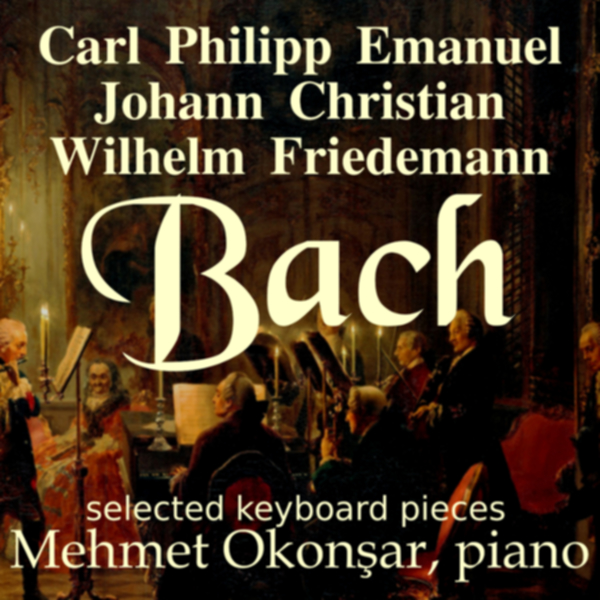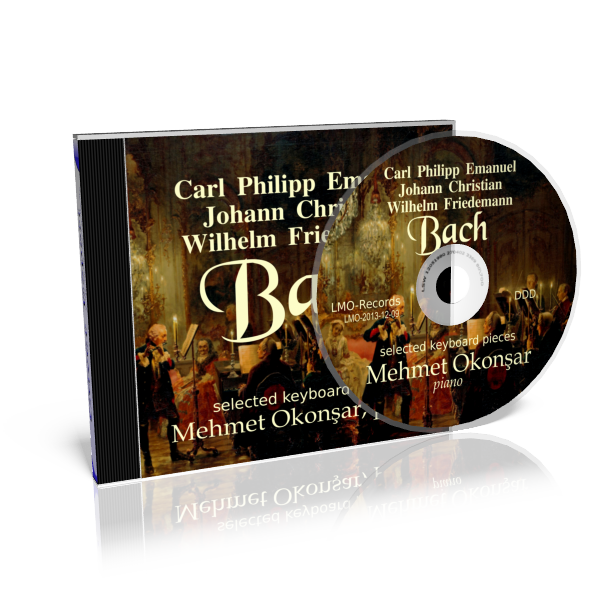
Last name: BACH
Carl Philipp Emanuel Bach Johann Christian Bach Wilhelm Friedemann Bach


|
Johann Sebastian Bach (1685-1750) was the summit and the end of a period of music composing. The myriads harmonic and instrumental innovations in his music are actually the results of the current polyphonic Baroque style reaching its climax and, at simultaneously its end. The composer sons of J. S. Bach, on the contrary, are renovators and innovators. They did not follow on their father's tracks, but instead, they have been the precursors of the "new style": the classical style. Joseph Haydn always referred and studied the sonatas of Carl Philipp Emanuel Bach. Obviously, the tutoring of Johann Sebastian Bach did not resulted in making more or less talented clones of himself, but genuinely creative and innovative musicians who wholeheartedly adopted the new instruments (the "piano-forte") and the new musical style which they developed to a point where Haydn and Mozart will naturally grow upon. Three of Johann Sebastian's composer sons are represented in this album. Carl Philipp Emanuel: the highly cultivated intellectual, successful virtuoso and theoretician; Wilhelm Friedemann: the "avant-garde" with delicate "Polonaises" and "Fantasias"; Johann Christian: the steady-going, almost "scholarly" one. Three of Johann Sebastian's composer sons are represented in this album. Each displaying, above an admirable musical background (no wonder as we know their teacher) one genuine personality. Carl Philipp Emanuel Bach (1714–1788): the highly cultivated intellectual, successful virtuoso, author of the landmark book: "Versuch uber die wahre Art das Clavier zu spielen" (Treatise on piano playing with examples and 18 sample pieces in 6 sonatas). Wilhelm Friedemann Bach (1710–1784): the "avant-garde" one; short, delicate, exquisite "Polonaises" and "Fantasias" composed without bar-lines. Johann Christian Bach (1735–1782): the steady-going one, presenting an almost "scholarly", brilliant but not adventurous approach to his art. The keyboard works of Carl Philipp Emanuel Bach were composed throughout his life. This is a gigantic "opus corpus". Sonatas, sonatinas, fantasies, polonaises, rondos, "solfeggios" in the style of preludes, minuets, duos for two keyboards, one concerto for keyboard alone in the style of the Italian Concerto by J. S. Bach and many short pieces with evocative titles in the French style. At the second part of the 18th. century, the instrumental music started a new form. The transition from the harpsichord to the "piano-forte" called for a new musical "ecriture". The high sensitivity to the performer's touch in the piano-forte (and at the clavichord) made possible the use of a large variety of dynamic and expressive effects. The clarity of the polyphony which was so obvious with the transparent sound of the harpsichord has been gradually replaced with a more vocal-like "singing" line at the top range and accompanying figures at the left hand. Carl Philipp Emanuel Bach was one and may be the most important composer who realized this shift in his musical style. He fully made possible to create the illusion of a vocal-like "singing" melody on the new keyboard instrument. The basis of the classical sonata form with its two themes, two parts in the first movement were clearly established by Carl Philipp Emanuel Bach. He composed over a hundred sonatas. Six Harpsichord Sonatas (The Wurttemberg Sonatas), Wq.49 (Bach, Carl Philipp Emanuel) Those sonatas, composed in Berlin in 1742 and published there in 1744 under the title "Opera II", are dedicated to the Duc Charles of Wurttemberg. The innovative and creative genius of Carl Philipp Emanuel Bach are expressed in those ravishing pages. The new, innovative dramatic effects are amazing: successive fermatas, unexpected silences, changes of tempos, audacious modulations, a vast keyboard range. Even though Johann Christian did also start music with his father, the influence of Johann Sebastian seems less apparent in his works. His elder brother Carl Philipp Emanuel (1714-1788) who took in charge most of his education left a deeper effect on Johann Christian's musical style. However, during his stay at his brother's place in Berlin, the shows of the Berlin Opera where the Italian style was dominant has to stamp on him to a large degree too. He also got a keen interest in the research of the Mannheim orchestra regarding instrumentation and new sound possibilities. This particular orchestra, formed with highly skilled musicians had then an international reputation. The serious counterpoint studies he got with Padre Martini in Milan also contributed for his particular musical style. We have in Johann Christian Bach a very particular mixture of styles and influences which, combined with his evident talent makes for a unique very eclectic style. This particular mixture of Italian and German, severity and frivolity, creates a musical language which always attracts, surprises and seduces. It is difficult to time-stamp precisely the keyboard works of Wilhelm Friedemann Bach. They are probably composed at Leipzig and Dresden and during the last episode of the composer's life. The works consist of Sonatas, ten Fantasies, preludes, many diverse short pieces, eight fugues. The "12 Polonaises" are among the most beautiful and original of those pieces. This is a complex work because even being profoundly attracted towards the "new style", Wilhelm Friedemann Bach was also deeply rooted in the "old style" which is the Polyphonic style of Johann Sebastian Bach, due to his musical education dispensed by his father. Therefore, "old" and "new" elements are constantly present in his works. Unlike Carl Philipp Emanuel who masterfully melted those elements also unlike Johann Christian who clearly turned to the "new", Wilhelm Friedemann Bach remained somehow "in between the styles." This lack of resolution for a clearly defined "genre and style" may be the reason his contemporaries saw in him an "undecided" composer. Today this is precisely what makes the unique charm of this music. CD Contents: Carl Philipp Emanuel Bach: Six Harpsichord Sonatas
(Wq.49) Württemberg Sonatas:
Sonata N.1 in A minor (Wq.49/1 - H.30) Sonata in B minor (Wq.49/6 - H.36) Johann Christian Bach: Sonata N.6 in B-flat
major (Op. 17/6 W.A 12)
Chromatic Fugue on B-A-C-H, W.YA 50 Wilhelm Friedemann Bach: Fantasie in E minor
(F.21)
Twelve Polonaises (F.12): (selection) No.2 in C minor
No.3 in D major No.4 in D minor
|
|||||||||||||||
| |
|||||||||||||||
| |
|||||||||||||||
|
|
|||||||||||||||
|



